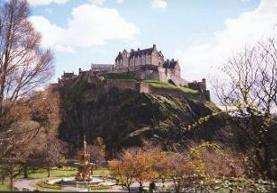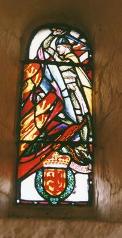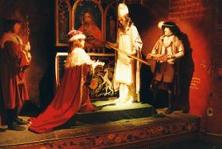
Edinburgh Castle sits on top of what was, at one time, a volcano - a 437 feet high plug of basalt rock. The shoulder of the Royal Mile runs east down from the castle and was formed when the whole of Scotland was covered by an ice sheet and the flow of the glacier ran from west to east - dropping rubble and earth in the lee of the rock. It has been used as a fortification for over 2,000 years - there was a hill fort there in the time of the Romans. The earliest known inhabitants of this part of the world were the Votadini (also known as the Gododdin, whose language was an early form of Welsh). Their bard Aneurin sang the praises of Din Eidyn (Dunedin or fortress on a slope) in the 6th century. After a raid into the territory of the Angles by King Mynyddog Mwynfawr and a defeat at Catterick in Yorkshire around AD 600, the area was subsequently captured by the Angles from the south in 638. They did not leave until about 300 years later. But the area we now know as Lothian was not captured and held by Malcolm II until after the Battle of Carham in 1018.
 The first record of the castle being used as a royal residence occurs in the 11th century when Margaret, wife of Malcolm III died there after hearing of her husband's death at Alnwick in 1093. "Saint Margaret" (she was later canonised) was Saxon-English, a refugee from the conquest of England by the Normans under William the Conqueror. She brought piety and manners to the Scottish court and was well known for her generosity to the poor. The chapel which bears her name (illustrated here) was probably not built until the 12th century.
The first record of the castle being used as a royal residence occurs in the 11th century when Margaret, wife of Malcolm III died there after hearing of her husband's death at Alnwick in 1093. "Saint Margaret" (she was later canonised) was Saxon-English, a refugee from the conquest of England by the Normans under William the Conqueror. She brought piety and manners to the Scottish court and was well known for her generosity to the poor. The chapel which bears her name (illustrated here) was probably not built until the 12th century.
The castle was used for keeping royal treasure and records and kings frequently lived in it. But when William the Lion was captured at Alnwick in 1174, Edinburgh was one of a number of castles handed over to Henry II of England. It was returned to Scotland in 1186 as part of the dowry on his marriage to an English noblewoman, Emardis de Beamont. Earlier in the 12th century, David I had assembled a group of nobles and clergy which eventually became the first Scots Parliament. It first met as such at the Castle in 1215, convened by Alexander II.

In 1291 Edward I of England again took the castle and removed the records and treasures, most of which were never returned. Edward's puppet king of Scotland, John Balliol occupied the castle and when Edward I returned in 1296 to depose him, the castle withstood a siege for eight days. With an English garrison of 350, and despite the successes of William Wallace (commemorated in a stained glass window in St Margaret's Chapel)
the castle remained in English hands until 1313. In that year, the Earl of Moray led a party of 30 men who scaled the cliffs and climbed over the walls into the castle. King Robert (the Bruce) ordered all the castle to be destroyed so that it could not be used again by the English. Only St Margaret's chapel was spared.
The rock was again occupied by the English in 1333 and the castle was partly rebuilt. In 1341, Sir William Douglas, disguised as a merchant, stopped his horse and cart under the portcullis and allowed a band of Scots to rush in and take the castle again. King David II and King Robert II added to the towers and walls. In the early 1400s Henry IV of England besieged the castle but had to withdraw because of bad weather and lack of supplies. By the end of the 15th century the castle was not much used as a royal residence, the Palace of Holyroodhouse at the other end of the Royal Mile being preferable. Nevertheless, James IV added to the Castle, including a Great Hall with a magnificent hammerbeam roof, supported on carved stone corbels. James V was brought to the castle for safety after his father, James IV was killed at the Battle of Flodden in 1513. James V built new royal apartments and his widow, Mary of Lorraine, stayed in the castle after her daughter, Mary (Queen of Scots) married the Dauphin of France in 1558.
After the death of the Dauphin, the young Mary Queen of Scots married Lord Darnley in 1565 and stayed in the Castle until the future James VI was born - the last monarch to be born in Scotland. In 1567, the year Mary's husband Lord Darnley was assassinated, Sir William Kirkcaldy of Grange became captain of the castle, appointed by the Regent Moray. But Sir William decided to support Mary and the castle became besieged. Sir William held the castle from May 1568 to May 1573. Finally, part of a tower built by King David collapsed and choked a well forming the main water supply, forcing the garrison to negotiate a surrender. Sir William was executed on 3 August 1573 and a plaque within the Castle recalls him as "Justly reputed to be one of the best soldiers and most accomplished cavaliers of his time."
 The Half Moon Battery (illustrated) was built over the remains of the tower which had collapsed during the siege. James VI also had the castle repaired in 1584 and in 1633, Charles I had a banquet in the Great Hall and slept in the castle before being crowned King of Scotland. The castle was again a focus during the time of the Covenanters who at one stage captured it. In 1650 it was besieged and captured by Cromwell. In the Revolution of 1689, the Duke of Gordon unsuccessfully defended the Castle on behalf of James VII after William of Orange had forced the Stuart king to flee to France. With only 120 men he inflicted 500 casualties on the besieging forces before finally surrendering. An attempt to capture the castle during the 1715 Jacobite uprising failed and in 1745 Prince Charles Edward Stuart blockaded the castle. During the Napoleonic Wars in the early part of the 19th century, many French and Dutch prisoners were kept in cellars under the Great Hall.
The Half Moon Battery (illustrated) was built over the remains of the tower which had collapsed during the siege. James VI also had the castle repaired in 1584 and in 1633, Charles I had a banquet in the Great Hall and slept in the castle before being crowned King of Scotland. The castle was again a focus during the time of the Covenanters who at one stage captured it. In 1650 it was besieged and captured by Cromwell. In the Revolution of 1689, the Duke of Gordon unsuccessfully defended the Castle on behalf of James VII after William of Orange had forced the Stuart king to flee to France. With only 120 men he inflicted 500 casualties on the besieging forces before finally surrendering. An attempt to capture the castle during the 1715 Jacobite uprising failed and in 1745 Prince Charles Edward Stuart blockaded the castle. During the Napoleonic Wars in the early part of the 19th century, many French and Dutch prisoners were kept in cellars under the Great Hall.
 The royal regalia, otherwise known as the "Honours of Scotland" consist of a crown, a sceptre and a sword and they are amongst the oldest crown jewels in Europe - the crown was first formed by King Robert I in the early 14th century. The last Scots coronation was in 1651 when Charles II was crowned at Scone. The regalia was kept hidden from Oliver Cromwell until the Restoration of the monarchy in 1660. They were displayed in the Scots Parliament until the Union of the Parliaments in 1707. Under the terms of the Union, the Honours of Scotland were not allowed to be removed to England and they were locked away in an oak chest in Edinburgh Castle - and forgotten about! They were rediscovered in 1818, largely due to the efforts of Sir Walter Scott, exactly as they had been left, over 100 years earlier. The regalia are now on display in the Castle - with a recent addition - the Stone of Destiny.
The royal regalia, otherwise known as the "Honours of Scotland" consist of a crown, a sceptre and a sword and they are amongst the oldest crown jewels in Europe - the crown was first formed by King Robert I in the early 14th century. The last Scots coronation was in 1651 when Charles II was crowned at Scone. The regalia was kept hidden from Oliver Cromwell until the Restoration of the monarchy in 1660. They were displayed in the Scots Parliament until the Union of the Parliaments in 1707. Under the terms of the Union, the Honours of Scotland were not allowed to be removed to England and they were locked away in an oak chest in Edinburgh Castle - and forgotten about! They were rediscovered in 1818, largely due to the efforts of Sir Walter Scott, exactly as they had been left, over 100 years earlier. The regalia are now on display in the Castle - with a recent addition - the Stone of Destiny.
Note that Rampant Scotland Channel on YouTube has a video of many of the external and internal aspects of Edinburgh Castle. See YouTube - Edinburgh Castle



